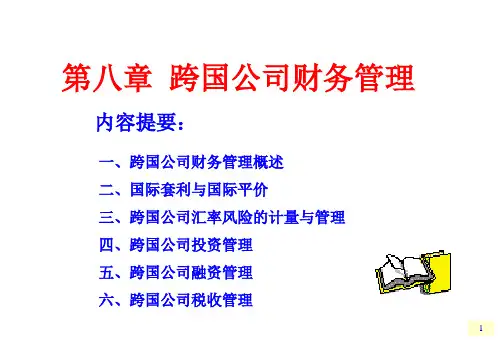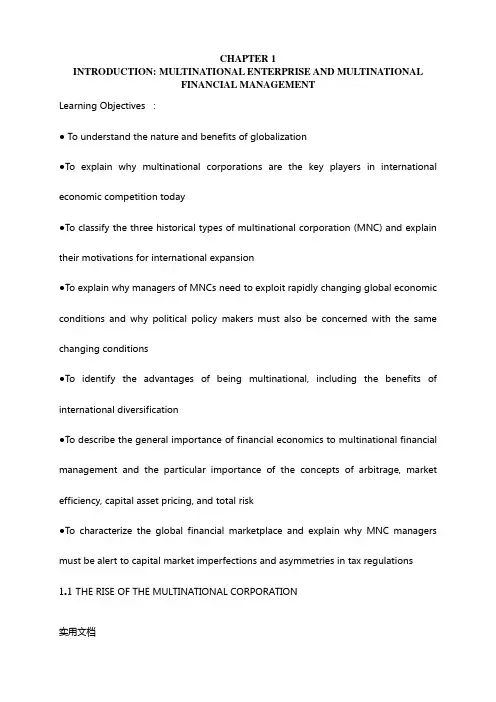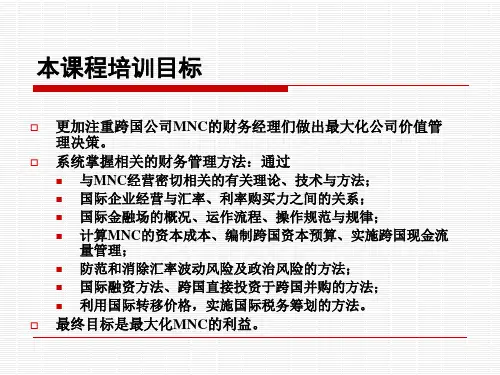跨国公司财务管理讲课讲稿
- 格式:doc
- 大小:41.50 KB
- 文档页数:7








CHAPTER 1INTRODUCTION: MULTINATIONAL ENTERPRISE AND MULTINATIONALFINANCIAL MANAGEMENTLearning Objectives :● To understand the nature and benefits of globalization●To explain why multinational corporations are the key players in international economic competition today●To classify the three historical types of multinational corporation (MNC) and explain their motivations for international expansion●To explain why managers of MNCs need to exploit rapidly changing global economic conditions and why political policy makers must also be concerned with the same changing conditions●To identify the advantages of being multinational, including the benefits of international diversification●To describe the general importance of financial economics to multinational financial management and the particular importance of the concepts of arbitrage, market efficiency, capital asset pricing, and total risk●To characterize the global financial marketplace and explain why MNC managers must be alert to capital market imperfections and asymmetries in tax regulations1.1 THE RISE OF THE MULTINATIONAL CORPORATION实用文档1.1.1A multinational corporation (MNC) is a company engaged in producing and selling goods or services in more than one country.1.1.2A brief taxonomy of the MNC and its evolutionRaw-Materials Seekers. Raw-materials seekers were the earliest multinationals, the villains of international business.Market Seekers. The market seeker is the archetype of the modern multinational firm that goes overseas to produce and sell in foreign markets.Cost Minimizers. These firms seek out and invest in lower cost production sites overseas (for example, Hong Kong, Taiwan, and Ireland) to remain cost-competitive both at home and abroad.1.1.3the true multinational corporation is characterized more by its state of mind than by the size and worldwide dispersion of its assets.1.1.4the essential element that distinguishes the true multinational is its commitment to seeking out, undertaking, and integrating manufacturing, marketing, R&D, and financing opportunities on a global, not domestic, basis.1.1.5In a world in which change is the rule and not the exception, the key to international competitiveness is the ability of management to adjust to change and volatility at an ever faster rate.1.1.6New global manager is needed.实用文档1.2 THE INTERNATIONALIZATION OF BUSINESS AND FINANCE1.2.1The existence of global competition and global markets for goods, services, and capital is a fundamental economic reality that has altered the behavior of companies and governments worldwide.1.2.2Politicians and labor leaders, unlike corporate leaders, usually take a more parochial view of globalization.1.2.3International economic integration reduces the freedom of governments to determine their own economic policy.1.2.4The stresses caused by global competition have stirred up protectionists and given rise to new concerns about the consequences of free trade.The U.S.–Canada trade agreement; the North American Free Trade Agreement (NAFTA),1.3 MULTINATIONAL FINANCIAL MANAGEMENT: THEORY AND PRACTICE1.3.1The main objective of multinational financial management is to maximize shareholder wealth as measured by share price.1.3.2Shareholders are the legal owners of the firm and management has a fiduciary obligation to act in their best interests.1.3.3Financial management is traditionally separated into two basic functions: theacquisition of funds (financing decision) and the investment of those funds 实用文档(investment decision).1.3.4The risks of multinational management include exchange and inflation risks; international differences in tax rates; multiple money markets, often with limited access; currency controls; and political risks, such as sudden or creeping expropriation.1.3.5The most advantage of MNC is the international diversification of markets and production sites.1.3.6Some concepts of financial economics:Arbitrage Market efficiency Capital Asset Pricing Risk classification1.4 OUTLINE OF THE BOOKThis book is divided into five parts.Part I: Environment of International Financial ManagementPart II: Foreign Exchange Risk ManagementPart III: Financing the Multinational CorporationPart IV: Foreign Investment AnalysisPart V: Multinational Working Capital ManagementCHAPTER 2THE FUNDAMENTAL OF INTERNATIONAL FINANCELearning Objectives:实用文档●To explain the concept of an equilibrium exchange rate●To identify the basic factors affecting exchange rates in a floating exchange rate system●To calculate the amount of currency appreciation or dep reciation associated with a given exchange rate change●To distinguish between a free float, a managed float, a target-zone arrangement, anda fixed-rate system of exchange rate determination●To distinguish between the current account, the financial accou nt, and the official reserves account and describe the links among these accounts2.1 SETTING THE EQUILIBRIUM SPOT EXCHANGE RATE2.1.1Exchange rates can be for spot or forward delivery.2.1.2A spot rate is the price at which currencies are traded for immediate delivery, or in two days in the interbank market.2.1.3A forward rate is the price at which foreign exchange is quoted for delivery at a specified future date.2.1.4The exchange rates are market-clearing prices that equilibrate supplies and demands in the foreign exchange market.2.1.5Factors that Affect the Equilibrium Exchange Rate:As the supply and demand schedules for a currency change over time, the equilibrium 实用文档exchange will also change.Relative Inflation Rates Relative Interest Rates Relative Economic Growth Rates Political and Economic Risk Expectation and Asset Market model2.1.6Calculating Exchange Rate Change2.2 ALTERNATIVE EXCHANGE RATE SYSTEMS2.2.1The international monetary system refers primarily to the set of policies, institutions, practices, regulations, and mechanisms that determine the rate at which one currency is exchanged for another.2.2.2This section considers five market mechanisms for establishing exchange rates: free float managed float target-zone arrangementfixed-rate system the current hybrid system.2.3 BALANCE-OF-PAYMENT CATEGORIES2.3.1The balance of payment is an accounting statement that summarizes all the economic transactions between residents of the home country and the residents of all other countries.2.3.2Currency inflows are recorded as credits, and outflows are recorded as debits. 2.3.3There are three principal balance-of-payments categories:1. Current account2. Capital account3. Financial account2.3.4For most countries, only the current and financial accounts are significant.实用文档CHAPTER 3COUNTRY RISK ANALYSISLearning Objectives:● To define what country risk means from the standpoint of an MNC● To describe the social, cultural, political, and economic factors that affect the gene ral level of risk in a country and identify key indicators of country risk and economic health ● To describe what we can learn about economic development from the contrasting experiences of a variety of countries● To describe the economic and political factors that determine a country’s ability and willingness to repay its foreign debts3.1 MEASURING POLITICAL RISK3.1.1Expropriation is the most obvious and extreme form of political risk,.3.1.2There are other significant political risks, including currency or trade controls, changes in tax or labor laws, regulatory restrictions, and requirements for additional local production.3.1.3Factors in political risk forecasting modelPolitical Stability Economic Factors Subjective FactorPolitical Risk and Uncertain Property Rights3.1.4A useful indicator of the degree of political risk is the seriousness of capital flight.实用文档3.2 ECONOMIC AND POLITICAL FACTORS UNDERLYING COUNTRY RISK3.2.1key factors that determine the economic performance of a country and its degree of riskFiscal Irresponsibility Monetary Instability Controlled Exchange Rate System Wasteful Government Spending Resource BaseCountry Risk and Adjustment to External Shocks3.2.2Key Indicators of Country Risk and Economic Health3.3 COUNTRY RISK ANALYSIS IN INTERNATIONAL BANKING3.3.1From a bank’s standpoint, country risk is the possibility that borrowers in a country will be unable or unwilling to service or repay their debts to foreign lenders ina timely manner.3.3.2What ultimately det ermines a nation’s ability to repay foreign loans is that nation’s ability to generate U.S. dollars and other hard currencies.3.3.3The Government’s Cost/Benefit Calculus3.3.4Lessons from the International Debt CrisisCHAPTER 4MEASURING AND MANAGING TRANSLATION AND TRANSACTION EXPOSURE Learning Objectives● To define translation and transaction exposure and operating exposure, distinguish 实用文档them.● To describe the four principal currency translation methods available and to calculate translation exposure using these different methods● To identify the basic hedging strategy and techniques used by firms to manage their currency transaction and translation risks● To describe the costs and benefit associated with using the different hedging techniques● To describe and assess the economic soundness of the various corporate hedging objectives4.1 ALTERNATIVE MEASURES OF FOREIGN EXCHANGE EXPOSURE4.1.1The three basic types of exposure are translation exposure, transaction exposure, and operating exposure.4.1.2Transaction exposure and operating exposure combine to form economic exposure.Translation exposure, also known as accounting exposure, arises from the need, for purposes of reporting and consolidation, to convert the financial statements of foreign operations from the local currencies (LC) involved to the home currency (HC). Transaction exposure results from transactions that give rise to known, contractuallybinding future foreign-currency-denominated cash inflows or outflows.实用文档Operating exposure measures the extent to which currency fluctuations can alter acompany’s future operating cash flows, that is, its future revenues and costs.4.2 ALTERNATIVE CURRENCY TRANSLATION METHODS4.2.1Companies with international operations will have foreign-currency-denominated assets and liabilities, revenues, and expenses. The financial statements of an MNC’s overseas subsidiaries must be translated from local currency to home currency before consolidation with the parent’s financial statements.4.2.2Four principal translation methods are available:the current/noncurrent method, the monetary/nonmonetary method,the temporal method, and the current rate method.4.2.3In practice, there are also variations of each method.4.2.4Current/Noncurrent methodAll the foreign subsidiary’s current assets and liabilities are translated into home currency at the current exchange rate. Each noncurrent asset or liability is translated at its historical exchange rate—that is, at the rate in effect at the time the asset was acquired or the liability was incurred.The income statement is translated at the average exchange rate of the period, except for those revenues and expense items associated with noncurrent assets or libilities.4.2.5Monetary/Nonmonetary Method实用文档Monetary items (for example, cash, accounts payable and receivable, and long-termdebt) are translated at the current rate; nonmonetary items (for example, inventory, fixed assets, and long-term investments) are translated at historical rates.Income statement items are translated at the average exchange rate during the period, except for revenue and expense items related to nonmonetary assets and liabilities. 4.2.6Temporal MethodUnder the temporal method, inventory is normally translated at the historical rate, but it can be translated at the current rate if the inventory is shown on the balance sheet at market values.in the temporal method, it is based on the underlying approach to evaluating cost (historical versus market).Income statement items normally are translated at an average rate for the reporting period.4.2.7Current Rate MethodThe current rate method is the simplest: All balance sheet and income items are translated at the current rate.4.4 DESIGNING A HEDGING STRATEGY4.4.1Hedging a particular currency exposure means establishing an offsetting currencyposition so as to lock in a dollar (home currency) value for the currency exposure and 实用文档thereby eliminate the risk posed by currency fluctuations.4.4.2The usefulness of a particular hedging strategy depends on both acceptability and quality.4.4.3The objectives in management bahaviorMinimize translation exposure; Minimize earnings fluctuations owing to exchange rate changes; Minimize transaction exposure; Minimize economic exposure; Minimize foreign exchange risk management costs; Avoid surprises4.4.4Costs and Benefits of Standard Hedging Techniques4.4.5Exposure NettingExposure netting involves offsetting exposures in one currency with exposures in the same or another currency, where exchange rates are expected to move in a way such that losses (gains) on the first exposed position will be offset by gains (losses) on the second currency exposure.4.4.6Accounting for Hedging and FASB 1334.5 MANAGING TRANSLATION EXPOSURE4.5.1Firms have three available methods for managing their translation exposure: (1) adjusting fund flows, (2) entering into forward contracts, and (3) exposure netting. 4.5.2Funds adjustment involves altering either the amounts or the currencies (or both)of the planned cash flows of the parent or its subsidiaries to reduce the firm’s local 实用文档currency accounting exposure.4.5.3Evaluating Alternative Hedging Mechanisms4.5.4Ordinarily, the selection of a funds-adjustment strategy cannot proceed by evaluating each possible technique separately without risking suboptimization.4.6 MANAGING TRANSACTION EXPOSUREVarious techniques for managing transaction exposure Forward Market Hedge Money-Market Hedge Risk shifting Pricing Decision Exposure netting Currency Risk Sharing Currency Collars Cross-Hedging Foreign Currency OptionsCHAPTER 5MEASURING AND MANAGING ECONOMIC EXPOSURELearning Objectives● To define economic exposure and exchange risk and distinguish between the two ● To define operating exposure and distinguish b etween it and transaction exposure ● To identify the basic factors that determine the foreign exchange risk faced by a particular company or project● To describe the marketing, production, and financial strategies that are appropriate for coping with the economic consequences of exchange rate changes● To explain how companies can develop contingency plans to cope with exchange risk 实用文档and the consequences of their ability to rapidly respond to currency changes● To identify the role of the financial exec utive in facilitating the operation of an integrated exchange risk management program5.1 FOREIGN EXCHANGE RISK AND ECONOMIC EXPOSURE5.1.1The most important aspect of foreign exchange risk management is to incorporate currency change expectations into all basic corporate decisions.5.1.2Economic exposure can be separated into two components: transaction exposure and operating exposure.5.1.3The exchange rate changes that give rise to operating exposure are real exchange rate changes. The real exchange rate is defined as the nominal exchange rate adjusted for changes in the relative purchasing power of each currency since some base period.5.2 THE ECONOMIC CONSEQUENCES OF EXCHANGE RATE CHANGES5.2.1Transaction exposure arises out of the various types of transactions that require settlement in a foreign currency.5.2.2The greater a company’s flexibility to substitute between home-country and foreign-country inputs or production, the less exchange risk the company will face. 5.2.3The major conclusion is that the sector of the economy in which a firm operates (export, import-competing, or purely domestic), the sources of the firm’s inputs(imports, domestic traded or nontraded goods), and fluctuations in the real exchange 实用文档rate are far more important in delineat ing the firm’s true economic exposure than isany accounting definition.5.3 IDENTIFYING ECONOMIC EXPOSUREAspen Skiing Company Petróleos Mexicanos Toyota Motor Company5.4 CALCULATING ECONOMIC EXPOSURE4.4.1Spectrum Manufacturing AB example5.4.2Spect rum’s Accounting Exposure5.4.3Spectrum’s Economic ExposureScenario 1: All Variables Remain the Same.Scenario 2: Krona Sales Prices and All Costs Rise; Volume Remains the Same. Scenario 3: Partial Increases in Prices, Costs, and Volume.5.6 MANAGING OPERATING EXPOSURE5.6.1Because currency risk affects all facets of a company’s operations, it should not be the concern of financial managers alone.5.6.2Marketing Management of Exchange RiskMarket Selection Pricing Strategy Product Strategy5.6.3Production Management of Exchange RiskInput Mix Shifting Production Among Plants Plant Location RaisingProductivity实用文档5.6.4Planning for Exchange Rate Changes5.6.5Financial Management of Exchange RiskCHAPTER 6INTERNATIONAL FINANCING AND NATIONAL CAPITAL MARKETS Learning Objectives● To describe trends and differences in corporate financing patterns around the world ● To define securitization and explain the forces that underlie it and how it has affected the financing policies of MNCs● To explain why bank lending is on the decline worldwide and how banks have responded to their loss of market share● To explain what is meant by the globalization of financial markets and identify the factors that have affected the process of globalization● To descri be the external medium and long-term financing options available to the multinational corporation● To identify the functions and consequences of financial markets● To describe the links between national and international capital markets● To describe the types and roles of development banks6.1 CORPORATE SOURCES AND USES OF FUNDS6.1.1Firms have three general sources of funds available: internally generated cash, 实用文档short-term external funds, and long-term external funds.6.1.2Financial Markets versus Financial IntermediariesBank borrowing vs sell securities6.1.3Financial Systems and Corporate GovernanceAffective corporate governance requires that everyone involved in governing the company must be assigned a carefully chosen role and they must be provided with responsibility, authority, and accountability, all to be done with the paramount objective of creating shareholder value.The difference in financial systems has real consequences for financial structures.6.1.4Globalization of Financial Markets6.2NATIONAL CAPITAL MARKETS AS INTERNATIONAL FINANCIAL CENTERS6.2.1The principal functions of a financial market and its intermediaries are to mobilize savings and to allocate those funds among potential users on the basis of expected risk-adjusted returns.6.2.2International Financial Markets6.2.3Foreign access to domestic MarketsThe foreign bond market The foreign bank market The foreign equity market6.2.4Globalization of financial markets has its downside6.3 DEVELOPMENT BANK实用文档6.3.1To help provide the huge financial resources required to promote the development of economically backward areas, the United States and other countries have established a variety of development banks, whose lending is directed to investments that might not otherwise be funded by private capital.6.3.2There are three types of development banks:the World Bank Group, regional development banks, and national development banks.6.3.3Private-Sector AlternativesCHAPTER 7THE EUROMARKETSLearning Objectives● To describ e the Eurocurrency and Eurobond markets and explain why they exist● To describe the characteristics and pricing of Eurocurrency loans, Eurobonds, Euronotes, and Euro-commercial paper● To explain the links between the Euromarkets and their domestic coun terparts7.1 THE EUROCURRENCY MARKET7.1.1A Eurocurrency is a dollar or other freely convertible currency deposited in a bank outside its country of origin.7.1.2U.S. dollars on deposit in London become Eurodollars.实用文档7.1.3The Eurocurrency market then consists of those banks—called Eurobanks—that accept deposits and make loans in foreign currencies.7.1.4Modern Origins of Eurocurrency7.1.5The creation of Eurodollar7.1.6Eurocurrency Loans7.1.7Relationship Between Domestic and Eurocurrency Money MarketsThe presence of arbitrage activities ensures a close relationship between interest rates in national and international (Eurocurrency) money markets.Interest DifferentialsEurocurrency Spreads7.1.8Euromarket Trend7.2 EUROBONDS7.2.1Unlike domestic bond markets, however, the Eurobond market is almost entirely free of official regulation and is instead self-regulated by the Association of International Bond Dealers.7.2.2Borrowers in the Eurobond market are typically well known and have impeccable credit ratings.7.2.3Links Between the Domestic and Eurobond MarketsPlacement Currency Denomination Interest rates实用文档Eurobond Retirement Ratings7.2.4Rational for Existence of Eurobond Market7.2.5Eurobonds versus Eurocurrency LoansCost of borrowing Maturity Size of issue Flexibility Speed7.3 NOTE ISSUANCE FACILITIES AND EURONOTES7.3.1The note issuance facility (NIF) allows borrowers to issue their own short-term Euronotes, which are then placed or distributed by the financial institutions providing the NIF.7.3.2Note Issuance Facilities versus EurobondsDrawdown flexibility Timing flexibility Choice of maturities7.3.3Euro-Medium-Term Notes 7.3.4Euro-Commercial Paper 7.3.5The Asiacurrency MarketCHAPTER 8THE COST OF CAPITAL FOR FOREIGN INVESTMENTSLearning Objectives● To determine the cost of capital for foreign investments and identify those circumstances under which that cost should be higher, lower, or the same as that for comparable domestic projects● To identify and address the key issu es involved in applying the capital asset pricing 实用文档model to estimate the cost of capital for foreign projects● To illustrate the impact of globalization on the cost of capital● To calculate the effective dollar costs of foreign currency borrowing taking into account interest rates, exchange rate changes, and taxes● To identify the relevant factors and tradeoffs in establishing a company’s worldwide capital structure● To calculate the value of below-market financing opportunities8.1 THE COST OF EQUITY CAPITAL8.1.1The cost of equity capital for a firm is the minimum rate of return necessary to induce investors to buy or hold the firm’s stock.8.1.2The Capital asset pricing model8.1.3The CAPM is based on the notion that intelligent, risk-averse shareholders will seek to diversify their risks, and, as a consequence, the only risk that will be rewarded with a risk premium will be systematic risk.8.1.4Weighted average cost of capital8.3 DISCOUNT RATES FOR FOREIGN INVESTMENTS8.3.1Key Issues in Estimating Foreign Project Discount Rates1. Should the corporate proxies be U.S. or local (i.e., foreign) companies?2. Is the relevant base portfolio against which the proxy betas are estimated the U.S. 实用文档market portfolio, the local portfolio, or the world market portfolio?3. Should the market risk premium be based on the U.S. market or the local market?4. How, if at all, should country risk be incorporated in the cost of capital estimates? 8.3.2Three alternatives for estimating proxy betas are proposed here.Local Companies Proxy Industry Adjusted U.S. Industry Beta8.3.3In employing the CAPM, the base portfolio against which the proxy betas are estimated can be the home portfolio or the global market portfolio.8.3.4The Impact of Globalization on the Cost of CapitalOther things being equal, the use of a global CAPM means a lower cost of capital for this company.8.3.5Empirical Evidence8.3.6The Relevant Market Risk Premium8.5 ESTABLISHING A WORLDWIDE CAPITAL STRUCTURE8.5.1The Cost of Debt CapitalIn general, the after-tax dollar cost of borrowing in the local currency for a foreign affiliate equals the after-tax interest expense plus the change in the exchange rate. 8.5.2The capital structure problem for the multinational enterprise is to determine the mix of debt and equity for the parent entity and for all consolidated andunconsolidated subsidiaries that maximizes shareholder wealth.实用文档8.5.3Foreign Subsidiary Capital StructureConform to the capital structure of the parent companyReflect the capitalization norms in each foreign countryVary to take advantage of opportunities to minimize the MNC’s cost of capital8.5.4Political Risk Management 8.5.5Currency Risk Management8.5.6Leverage and Foreign Tax Credit 8.5.7Leasing and Taxes8.5.8Cost-Minimizing Approach to Global Capital Structure8.5.9Valuing Low-Cost Financing OpportunitiesTaxes Zero-Coupon Bonds Debt versus Equity Financing8.5.10Government Credit and Capital Control 8.5.11Government Subsidies and IncentivesCHAPTER9INTERNATIONAL PORTFOLIO INVESTMENTLearning Objectives● To describe the risks and advantages of international investing● To explain how international investing can allow investors to achieve a better risk-return trade-off than by investing solely in U.S. securities● To identify the barriers to investing overseas实用文档● To describe the various ways in which U.S. investors can diversify into foreignsecurities● To calculate the currency risk associated with investing in securities issued in different markets and denominated in various currencies● To calculate the return associated with investing in securities issued in different markets and denominated in various currencies9.1 THE RISKS AND BENEFITS OF INTERNATIONAL EQUITY INVESTING9.1.1The risks of international investing1. Changes in currency exchange rates2. Dramatic changes in market value3. Political, economic, and social events4. Lack of liquidity5. Less information6. Reliance on foreign legal remedies7. Different market operations9.1.2This relation follows from the basic rule of portfolio diversification: The broader the diversification, the more stable the returns and the more diffuse the risks.9.1.3Correlations and the Gains from DiversificationForeign market betas, which are a measure of market risk derived from the capital asset pricing model, are calculated relative to the U.S. market in the same way that individual asset betas are calculatedThe obvious conclusion is that international diversification pushes out the efficientfrontier—the set of portfolios that has the smallest possible standard deviation for its 实用文档level of expected return and has the maximum expected return for a given level ofrisk—allowing investors simultaneously to reduce their risk and increase their expected return.9.1.4Investing in Emerging Markets 9.1.5Barriers to international Diversification9.2INTERNATIONAL PORTFOLIO INVESTMENT1International Bond Investment2Optimal International Asset Allocation3Measuring the Total Return From Foreign Portfolio InvestingIn general, the total dollar return on an investment can be divided into three separate elements: dividend/interest income, capital gains (losses), and currency gains (losses). Bond; stock4Measuring Exchange Risk on Foreign SecuritiesCHAPTER10CORPORATE STRATEGY AND FOREIGN DIRECT INVESTMENT Learning Objectives● To identify the stages of corporate expansion overseas by which companies gradually become multinational corporations (MNCs)● To identify the fundamental motives for companies to invest abroad in order t odetermine those foreign investments that are most likely to be successful实用文档。



跨国公司的财务管理特点:1.汇率变动的波动不定和难以预测带来了更大的外汇风险。
如交易风险、经济风险和换算风险。
2.市场的不完全性给公司带来了更大的机遇和风险。
如不完全的商品市场,不完全的要素市场以及政府对经济的干预等。
●在国际金融市场快速发展和金融工具不断创新的背景下,跨国公司面临更多的机遇和挑战。
●跨国公司全球化经营,使得国际资本市场、东道国金融市场、母公司所在国资本市场等都成为跨国公司的融资渠道,跨国公司内部还可以进行资金调度。
●跨国公司经营的特征是国际化、多样化、内部化和全球化。
跨国公司为发挥其经营优势、降低风险,一般在统一的指挥下实现一体化的生产体系。
3.多层次的委托以代理关系,使跨国财务控制成为关键。
跨国公司财务管理的主要内容是什么?财务风险管理:跨国公司的财物管理是建立在一般公司财务管理的基本原理之上,但当企业的财务活动跨越了过境之后,面临各国经济状况、政治气候、法律环境、文化背景的不同,财务管理的问题就相应的变得更复杂。
在复杂的环境中开展跨国理财活动的跨国公司,由于受诸多不确定性因素的影响所面临的可能收益或潜在的损失,就是跨国公司的财务管理风险。
客观上要求跨国公司具体分析、评估国际形势和各国情况,以应付复杂的理财环境,提高财务决策的正确性和及时性。
风险管理薄弱会给企业带来巨大损失。
筹资管理:是跨国公司财务管理最基本的活动之一。
在筹资管理方面,跨国公司应做好如下工作:正确确定投资需要量,在此前提下,合理确定筹资数额,安排资金结构;拟订两个以上可行的筹资方案,并对其进行经济分析,从中选出最优筹资方案;优化资金结构,降低资金成本,防范筹资风险。
投资管理:跨国公司投资是指跨国公司将筹集到的资金跨越国界用于国际生产经营活动,以获得比国内经营更高的利润的一种投资行为。
跨国公司的国外投资可分为短期投资和长期投资。
为了提高投资管理的效率,跨国公司应做好如下工作:把握投资机会,拟订两个以上的投资方案;对投资方案进行可行性研究,评选出最佳投资方案;实施最优投资方案,力求降低投资风险并提高投资收益。
营运资金管理:跨国公司营运管理在跨国公司财务管理中处于特别重要的地位。
包括营运资金的存量管理和营运资金的流量管理。
营运资金的存量管理着眼于各类资金处置,目的是使现金、应收账款和存货处于最佳持有水平。
其管理的重点在于:妥善处理好各种资产的组合关系,使总公司及其所属各子、分公司对流动资金上的占用实现最优配置,对国际企业短期资金的来源渠道、货种作出选择。
营运资金的流量管理着眼于资金从一地向另外一地的转移,其目的是使资金得到合理的安置,确定最佳的安置地点和最佳的持有币种,以避免各种可预见的风险和损失。
做好营运资金管理,应注意以下几点:保持合理的资金结构,改善资金的营运环境;加强现金、应收账款和存货管理,提高其管理水平;合理制定内部转移价格,谋求公司最大利益;分析资金营运情况,及时发现并采取措施解决存在的问题。
纳税管理:要实现整体税后收益最大化的目标,充分、合理地组织资金流动,不仅要加强收入费用的管理,更要注重对国际税负的控制,力争使公司整体税负最低。
为了减轻税负,加强纳税管理,跨国公司应做好如下工作:熟悉有关国家的税法,选择税负较轻、税收优惠较多的国家进行投资;掌握母公司所在国与子公司东道国签订的关于避免双重征税的协定,避免重复征税;通过企业内部转移价格将利润由高税国向低税国转移,减少税款支付;将母公司从子公司分得的利润用于国外在投资,避免重复征税或减轻税负。
如何看待跨国公司财务管理的环境?其影响因素有哪些?跨国公司财务管理的环境是指决定和影响跨国公司财务管理的各种自然因素、经济因素、法律因素和社会因素相互影响、相互综合而形成的矛盾统一体。
狭义的财务管理环境包括一国的经济发展水平、经济体制、基础设施、外汇管制、金融市场等;广义的财务管理环境不仅包括狭义的跨国公司财务管理环境,还包括一国的政治、文化、法律、劳动力等因素。
按照环境的属性分:可分为自然环境和社会环境按照表现形态划分:可分为软环境和硬环境按照范围划分:可分为宏观环境、微观环境。
影响因素:经济环境:主要是指一国所采取的经济体制,所处的经济周期,以及经济结构和经济发展水平。
金融环境:金融市场、金融机构、金融工具税收环境:跨国公司税收种类——公司所得税,增值税、营业税、预扣税、过境税跨国公司税收的纳税人与征税对象跨国公司税负的主要因素——应税收入的确定、费用的确认政治与法律环境——政治环境是指国家政治,包括国家政权、政治思想与纲领法律环境:跨国公司经常会牵扯到一些跨国经济纠纷。
其他经济环境——通货膨胀、利率和汇率、人力资源跨国公司财务管理的目标有哪些?与一般企业相比,跨国公司财务管理的目标有哪些不同之处?跨国公司财务管理的目标:利润最大化:财务管理的目标定义为利润最大化,缺点在于没有考虑货币的时间价值,容易使财务决策带有短期行为,追求短期利益的最大化。
净现值最大化:即企业必须各种投资的预期现金流量、贴现率和到期风险。
克服了利润最大化的不足之处,但仍然不够完善。
资本成本最小化:在净现值最大化的基础上,如果资本成本最小,那么企鹅也的总价值就会是最大的股东财务最大化:股价越来越能够反映出企业的经营状况和未来的经济价值,股东财富最大化开始成为企业追求的财务目标。
不仅克服了利润最大化的缺点,而且有利于增加社会财富,成为企业财务管理的最优目标。
差异:法国、日本、荷兰等国家的公司倾向于以总收入作为财务管理的目标挪威以分红或税前收益作为目标美国以每股收益为目标应包括三个方面的目标:公司的长期合并收益(每股)、公司的现金流动、公司的市场价值外汇风险有哪几种类型?请比较他们之间的异同。
外汇风险:由于各国货币市场汇率的变化,可能会给跨国公司带来的损益。
类型:折算风险:也称为会计风险,是指跨国公司在编制财务报表和合并财务报表过程中,将国外子公司以外币表示的财务报表折算为母公司所在地的本国货币时,由于汇率的变动而引起的帐面上损益的风险。
交易风险:是指跨国公司在特定的以外币计价的交易中取得的外币债权或承担的外币义务,由于未来结算时的汇率与交易发生时的汇率不同而引起的未来外币现金流本币价值变化的风险。
经济风险:是指跨国公司的生产成本、销售数量、产品价格等由于非意料到的外汇汇率的变动而发生变化,进而使公司的国际竞争地位发生变化,由此引起的公司未来外币现金流量本币价值的不确定性。
比较:1、折算风险是由于汇率变动而引起的资产负债表和损益表各项目的变动,所导致的损益只是帐面上的2、交易风险和经济风险都会引起跨国公司未来现金流量的变动,所导致的损益是实际发生的。
3、交易风险也属于经济风险,它们的区别在于:交易风险是由已经签订但尚未履行的合同的价值变化引起的现金流量的变化。
经济风险是由于未发生的、预期的交易引起的现金流量的变化。
4、折算风险度量以过去的经济活动为基础,具有追溯性;经济风险的度量基于未来的经济活动,具有前瞻性5、交易风险的度量是基于过去发生、未来结算的经济活动,所以同时具有追溯性和前瞻性。
6、折算风险和交易风险是在一定时期内发生的,一般不会超过一年,只表明了短期内汇率变动对公司损益的影响7、经济风险则没有确切的时间范围,可以是短期的,也可以是长期的,不过,大多数情况下都是中长期的8、交易风险得有些因素已经在财务报表中反映,则已包括在折算风险中,如外币标价的应收账款和应付账款9、交易风险中的其他因素,如已经签订以外币计价的未来购销合同,因为没有应付、应收账款,所以也没有反映在财务报表中,属于经济风险。
10、对于跨国公司来说,经济风险比折算风险和交易风险更复杂更重要,它对跨公司的影响具有战略性和全面性。
因此,经济风险的规避措施也比折算风险和交易风险复杂得多。
货币折算方法有哪几种,采用不同的折算方法对跨国公司有什么影响?1、流动/非流动项目区分折算法:是指在将跨国公司的所有国外子公司的资产和负债折算为本币时,流动资产和流动负债采用报表日的现行汇率折算,而非流动资产或负债则按照取得或发生时的汇率折算,即按历史汇率折算。
影响:折算后营运资本可能为正,当货币贬值(升值)时,会发生折算损失(收益)。
但是,折算后营运资本为负时,情况恰好相反。
对于非流动资产和负债,因为它们的折算汇率是固定的,所以折算时不会面临折算风险。
2、货币/非货币项目区分折算法:首先要把跨国公司国外子公司资产负债表中的项目区分为货币性资产负债和非货币性资产负债。
货币性资产负债采用现行汇率折算。
非货币性资产和负债在折算时采用历史汇率。
3、时态法:是货币/非货币项目区分折算发的一种变形,对存货的不同处理是它们的唯一区别。
存活总是安历史汇率折算。
使用时态法时,如果存货以现时成本表示,可以按现行汇率折算;如果存货以历史成本表示,则按历史汇率折算。
货币/非货币项目区分折算法是对资产负债的简单划分,而时态法是根据成本估价模式选择折算汇率,涉及外币折算的本质。
4、现行汇率法:是将跨国公司国外子公司的全部资产和负债项目折算为本币时,均采用现行汇率。
对于股东权益中的实收资本,则采用历史汇率折算;损益表中的收入和费用,按确认时的历史汇率折算。
我国在折算时也采用现行汇率法。
汇率预测的方法有哪几种,它们分别适用于何种情况?固定汇率制下的汇率预测:适用于对外汇实行管制的国家。
政府和央行通过采取干预行为对汇率进行调节。
最关键的就是政策分析,明确经济分析和政府政策的关系。
通过经济分析,可以估算出某一时期的均衡汇率,并给出多种汇率调整的方案。
但是,汇率变动的时机和幅度主要由政府采取的政策决定。
外汇管制汇率制下的汇率预测:各国政府为了本国的自身利益,除了采取限制进口和资本流动措施外,还普遍采取外汇管制措施,从而掩盖了汇率变动的真实压力。
自由浮动汇率制下的汇率预测1)基于市场的汇率预测方法:利用远期汇率和利率的方法预测未来即期汇率的变动趋势。
2)基于模型的汇率预测方法:基本因素分析预测法——全面分析影响汇率变动趋势的各种宏观经济政策与经济变量之间的关系进行汇率预测。
技术分析预测法——不涉及各种经济变量和政治因素对汇率变动趋势的影响,仅仅依据该汇率自身的变化规律,通过以往的价格和成交量等指标进行汇率预测。
(图形分析法和时间序列分析法)混合汇率预测方法:主要是因为目前还没有发现哪种预测方法总是优于其他预测方法。
跨国公司在筹资过程中主要存在哪几种风险?财务风险:因为存在财务风险,企业决策层需合理安排资本结构,控制负债比率,适度负债,使财务杠杆利益抵消风险增大所带来的不利影响。
代理风险:投资者一般通过投资多样化,分散掉证券组合中的大部分风险。
控制风险:是指现有管理层的控制地位会受到发行新股或是举债的决定的影响。
跨国公司投资风险表现在哪几个方面?跨国公司通过什么办法来控制投资风险?跨国公司投资风险主要有两个方面:一是某个投资项目特有的风险,也叫跨国公司投资的特定风险二是所有投资项目共有的风险,也叫投资的市场风险控制投资风险的基本模型:资本资产定价模型(CAPM)、套利定价模型、多因子模型、回归模型什么是跨国公司营运资金管理?其主要内容有哪些?营运资金管理是跨国公司财务管理的一个重要内容,加强营运资金管理,可以减少资金成本,合理有效的使用资金,实现企业利润的最大化。